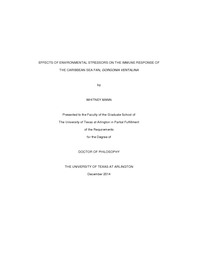
ATTENTION: The works hosted here are being migrated to a new repository that will consolidate resources, improve discoverability, and better show UTA's research impact on the global community. We will update authors as the migration progresses. Please see MavMatrix for more information.
Show simple item record
| dc.contributor.author | Mann, Whitney | |
| dc.date.accessioned | 2017-05-31T19:27:28Z | |
| dc.date.available | 2017-05-31T19:27:28Z | |
| dc.date.issued | 2014-12 | |
| dc.date.submitted | January 2014 | |
| dc.identifier.other | DISS-12901 | |
| dc.identifier.uri | http://hdl.handle.net/10106/26692 | |
| dc.description.abstract | Coral reef ecosystems are some of the most diverse on the planet and provide many important services such as fishery stock, tourism, and protection against storms. Despite this, coral reef ecosystems are on a steady rate of decline due largely to increases in disease prevalence. Coral diseases are associated with environmental stressors such as rising sea surface temperatures and acidified water conditions that have resulted from artificial increase atmospheric CO2 levels by anthropogenic activities. It is hypothesized that the presence of environmental stressors is compromising coral immunity while also exacerbating pathogen virulence and contributing to the development of disease. The Caribbean sea fan (<italic>Gorgonia ventalina</italic>) has been one of the many species greatly affected by disease outbreaks. Two of the most prevalent diseases include aspergillosis caused by fungal pathogen, <italic>Aspergillus sydowii</italic> and a yet, unnamed disease caused by an <italic>Aplanochytrium</italic> sp. protist pathogen (order: Labyrinthulomycetes). Using the sea fan and its associated pathogens as a coral disease model, this dissertation addresses several fundamental hypotheses regarding the effects of climate change on coral disease ecology. H1 - Elevated temperatures can lower the sea fan immune responses, such as production of inhibitors of pathogen proteases while exacerbating putative pathogen virulence factors such as protease production. H2 - Multiple stressors can have a synergistic adverse effect on the sea fan immune response versus the presence of only one stressor. H3 - Responses of the sea fan can vary depending on the type of pathogen and can this can be additionally affected by environmental stress. Several key experiments were conducted using the sea fan to address these hypotheses. In chapter 2, a new putative virulence factor (the production of proteases) in the sea fan fungal pathogen, <italic>Aspergillus sydowii</italic> and immune defense of the sea fan (protease inhibitor production) was identified (Mann et al. 2014). Inhibitors of the sea fan were seen to directly interact with proteases extracted from <italic>A. sydowii</italic>. When grown at elevated temperatures (30°C), protease activity of <italic>A. sydowii</italic> was significantly higher than at ambient temperatures (25°C). Temperature stress did not induce a change in protease inhibitor activity, but in healthy <italic>G. ventalina</italic> colonies inhibitor activity against proteases were higher than in diseased individuals. Chapter 3 utilized a multi-factorial experimental design to test the effects of multiple stressors (elevated temperature and acidification) and to exposure of the <italic>Aplanochytrium</italic> pathogen on the sea fan immune system. This experiment used a large suite of biochemical immunoassays to measure antimicrobial, anti-pathogenic, and antioxidant immune mechanisms. Together, the three factors (temperature, pH, and pathogen-exposure) had interactive and immuno-suppressive effect on the overall immune response. Although pH had effect on the sea fan immune response, this was only evident when combined with elevated temperature or pathogen-exposure. Additionally, an immune-suppressive effect on the sea fan's immune response was observed from the <italic>Aplanochytrium</italic> pathogen independent of the environmental stressors. The immuno-suppressive effect of a coral pathogen has yet to be fully documented. Effects of thermal stress were further examined in chapter 4, where sea fans were exposed to a period of thermal stress prior to exposure to the two pathogens, <italic>A. sydowii</italic> and the <italic>Aplanochytrium</italic>. This study utilized a biochemical immunoassay suite as well as novel gene expression analysis to measure immune mechanisms such as immune signaling, antimicrobial, anti-pathogenic, and antioxidant activity. The exposure to preceding thermal stress adversely affected the overall capability of sea fans to respond to the pathogens and this was most evident in the immune signaling and antimicrobial defense mechanisms. Moreover, this chapter illustrates the variation in response to the two pathogens where response to <italic>A. sydowii</italic> was slightly greater than to the <italic>Aplanochytrium</italic> pathogen.The combined works of this dissertation effectively demonstrate how compounding factors of climate change are adversely affecting coral immunity and leading to the development of diseases. Moreover, these studies incorporate several novel techniques and approaches towards the study of coral immunity that can be applicable to managers and conservationists to use towards better management of coral reef ecosystems around the Caribbean. | |
| dc.description.sponsorship | Mydlarz, Laura | |
| dc.language.iso | en | |
| dc.publisher | Biology | |
| dc.title | Effects Of Environmental Stressors On The Immune Response Of The Caribbean Sea Fan, Gorgonia ventalina | |
| dc.type | Ph.D. | |
| dc.contributor.committeeChair | Mydlarz, Laura | |
| dc.degree.department | Biology | |
| dc.degree.discipline | Biology | |
| dc.degree.grantor | University of Texas at Arlington | |
| dc.degree.level | doctoral | |
| dc.degree.name | Ph.D. | |
Files in this item
- Name:
- Mann_uta_2502D_12901.pdf
- Size:
- 1.596Mb
- Format:
- PDF
This item appears in the following Collection(s)
Show simple item record


